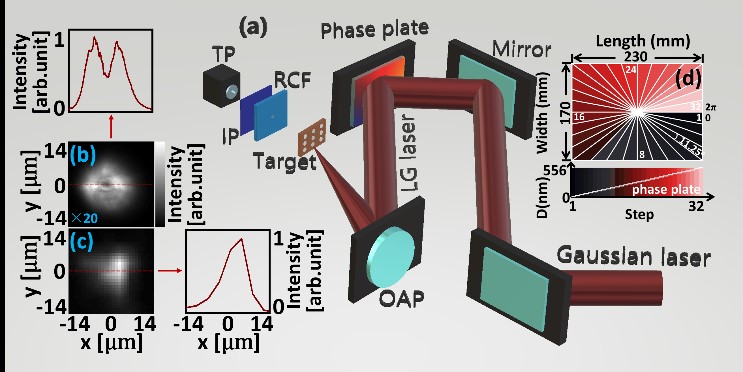In a recent study, Prof.WANG Wenpeng and his cooperators at Shanghai Institute of Optics and Fine Mechanics, Chinese Academy of Sciences, had produced the highest-intensity vortex laser in the world and realized the hollow proton beam acceleration in experiments. This research was published in Physical Review Letters.
A. Ashikin, G. Mourou, and D. Strickland were awarded the 2018 Nobel Prize in Physics for groundbreaking inventions in the field of laser physics. In 1970, A. Ashikin invented the optical tweezers to manipulate particles in various applications. Then, Allen et al. recognized that vortex light, such as Laguerre-Gaussian (LG) light, has a hollow-structure intensity distribution, which has been applied to manipulate micrometer-scale matter as a special tweezer, and in microscopy and imaging, atomic and nano-particle manipulation, optical communications, quantum computing, and astrophysics.
Nowadays, the laser intensity can significantly exceed 1018 W/cm2 with the development of chirped pulse amplification technology, which allows the previously weak LG light to be possibly turned into relativistic LG laser (> 1018 W/cm2).
In their experiment, researchers applied a high-reflectivity phase mirror in the femtosecond petawatt laser system to generate a relativistic hollow laser at the highest intensity of 6.3×1019 W/cm2 for the first time, addressing the present difficulty in experimentally generating relativistic Laguerre-Gaussian laser, primarily due to damage caused to optical modulators.
A simple optical model was used to verify that the vortex laser may be generated in this new scheme; using such a relativistic vortex laser, the hollow plasma drill and acceleration were achieved experimentally and proven by the particle in cell simulations.
With the development of the petawatt laser, this scheme opens up possibilities for the convenient production of the relativistic hollow laser at high repetition and possible hollow plasma acceleration, which is important for a wide range of applications such as the generation of radiation sources with orbital angular momentum, fast ignition for inertial confinement fusion, and jet research in the astrophysical environment.
This project was supported by the National Natural Science Foundation of China, the Chinese Academy of Sciences, Strategic Priority Research Program of the Chinese Academy of Sciences, Key Research Programs in Frontier Science, and Shanghai special science and technology innovation supported project.

Figure: Experimental setup. (Image by SIOM)
Article website:
https://link.aps.org/doi/10.1103/PhysRevLett.125.034801
Contact:
Mr. CAO Yong
General Administrative Office
Shanghai Institute of Optics and Fine Mechanics, CAS
Email: caoyong@siom.ac.cn